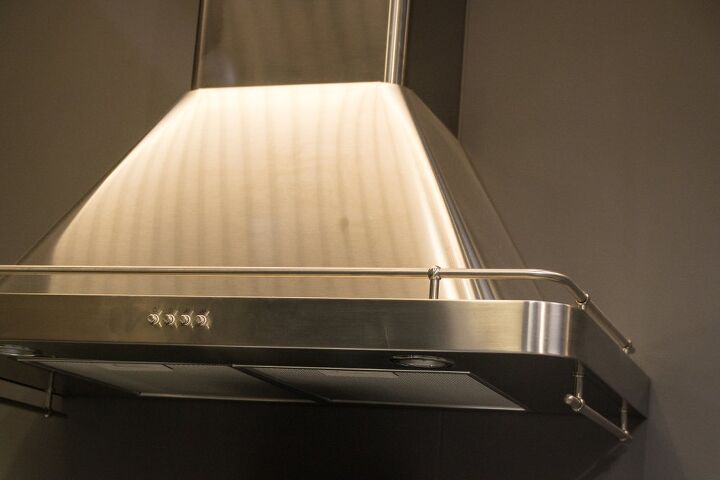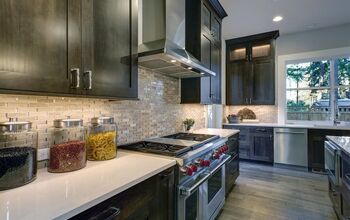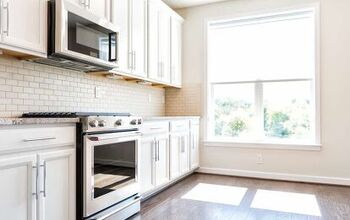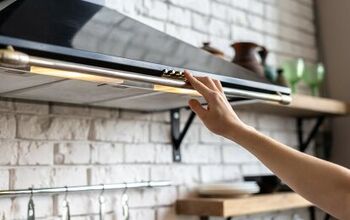How To Vent A Range Hood On An Interior Wall

When it comes to cooking, especially grilling and frying, you inevitably release a lot of greases, smoke, and lingering food odors. In order to obtain proper circulation and keep the air in your kitchen clean, it’s necessary to install a range hood.
To vent a range hood on an interior wall, begin by making the hole three feet away from structures including toilet vents and chimneys. Drill from the inside of the attic. Next, remove roofing shingles, and attach the vent to your roof and use roof grading caulk to seal it. Mark the cabinets and attach ductwork.
If you have a one-story house, you will generally vent up through the attic and out your roof. Whereas, if you have multiple levels, you can route it into the cabinet above the stove and then direct it sideways to the nearest exterior wall.
Although this may seem complicated, once you choose a route, whether it be through the ceiling or a nearby wall, the installation process is relatively straightforward. In this article, we’ll go into further detail about different range hood models and provide you with detailed steps and tips on how to install a range hood on an interior wall.
Do You Need Ducts or Vents Installation or Replacement?
Get free, zero-commitment quotes from pro contractors near you.

Why A Vented Instead Of An Unvented Range Hood?
Before we explain why a vented range hood is preferable, it’s essential to understand the difference. There is a fan attached to a duct that moves the air from the kitchen to the outdoors in a vented range hood. While an unvented range hood has a fan but does not have a duct. Without the duct, it uses several kinds of filters in order to purify the air, and then it gets recirculated back into the kitchen. These types are sometimes referred to as ductless range hoods or recirculating range hoods.
Undoubtedly, it’s much more desirable and safer to vent the air outside than to recirculate it back into the kitchen. Using a vented hood is the best way to keep your kitchen clean as it will remove smoke, heat, unwanted cooking odors and eliminate grease particles that would end up on your cabinets and walls.
Unvented range hoods are simply not as effective when filtering out cooking odors and grease. Also, their most prevalent downside is the fact that they do not remove heat and humidity. Opt for a vented range hood to keep your kitchen cool while you are cooking.
What Do I Need To Consider When Shopping For A Vented Range Hood?
Depending on the layout, the overall size of your kitchen, and type of cooking that you typically do, there are many factors to keep in mind. Here are just a few things to consider:
- CFM: This stands for cubic feet per minute and refers to how strong the fan is. It’s a measurement of the time it takes for the air in the room to be filtered through the range hood.
- Size: It’s important that the hood covers the entire area above the range. Measure the size of your stove before shopping to ensure that the hood captures discharges for all of your burners.
- Noise level: Although there is no such thing as a silent range hood, some are louder than others. Compare different models and read the specifications to decide based on your preference. Generally, the more powerful the fan is, the noisier it will be.
- Design: Nowadays, designers are crafting European-style range hoods that resemble sculptures. Your range hood will be very visible in your home, so it’s essential to choose one that matches your desired look.
Before You Purchase A Vented Range Hood
Before purchasing, be sure to read user comments and reviews on consumer websites to make sure you’re making an informed decision. Ensuring that you do your research will help so that you don’t get any item that has questionable quality. This helps so that you can get the best bang for your buck.
Now that you have a better understanding of vented range hoods let’s dive into the steps on how to vent your range hood on an interior wall.
Installing A Vented Range Hood Through The Ceiling
Whatever your desired path for ventilation, be sure that the total duct length doesn’t surpass the fan’s capacity. Check the owner’s manual that came with your range hood for specifics on duct lengths and sizes.
Installing a range hood by way of your ceiling is also referred to as venting vertically. You’ll want to acquire a sufficiently sized duct that will go all the way through your ceiling, into your attic, and out the roof. If you’re especially handy, installing a roof vent can be done by yourself; however, we recommend hiring a roofing contractor for the job.
Duct work is typically around 10” wide and an accordion style. You’ll also need to purchase a roof vent that has the same size opening. Begin this project by choosing the location of your roof vent.
Steps To Install A Range Hood Through The Ceiling
- Create the hole three feet away from structures. Make sure that the hole you drill in your roof is at least three feet away from any toilet vents, chimneys, or other roof protrusions. If your vent is installed improperly, this can cause frequent leaks into your home.
- Drill from the inside of your attic. Once you’ve identified the location of your roof vent, drill a hole through the roof from the inside of your attic. You’ll then need to cut an appropriately sized opening that will fit the design of your range hood vent.
- Use a roof grading caulk. Remove any roofing shingles on both sides of the opening; you’ll use these later. Affix the vent to your roof and seal underneath the flange with roofing-grade caulk. Take the shingles you removed and use them to flash on both sides of the vent.
- Mark your cabinets. Lastly, in your kitchen, mark the cabinets, cut any necessary holes for the ducts, and attach all ductwork to the roof vent.
Installing A Vented Range Hood Through An Exterior Wall
Though less common, your ductwork can run through an exterior wall of your house. However, since your vented range hood is not located on an exterior wall, you will have to first go through the ceiling or through your surrounding cabinets.
Since your stove is located on an interior wall, in order to vent through an exterior wall, you can run the duct through your ceiling or cabinets and connect it to an exterior wall nearby. Instead of venting out through your roof, the air in your kitchen will be filtered out through an exterior wall.
Steps To Install A Range Hood Through An Exterior Wall
The steps for this type of ventilation are very similar, with a few differences.
- Choose your vent. First, you will require a vinyl vent and some accordion ductwork. You also have the option of using a dryer vent instead, but keep in mind that they are only 4″ wide.
- Fasten the vent to the mounting box. Purchase a vinyl mounting box that is 12×18″, and cut a circular hole that will fit the size of your ductwork. Next, fasten the vent system to the mounting box using long flat-head screws around the perimeter. Screw these in about 2-3” apart.
- Seal it up. Seal any space between the vent and mounting box using exterior caulk. You’ll also want to trim the flange on the vent according to the size of the mounting box. Finally, attach the accordion ductwork to your vent, and you’re all set!
What If My Range Hood Has A Chimney?
If your range hood has a chimney, then there’s something you need to look out for. Range hoods with a brick chimney have become increasingly popular, but the chimney only extends to an 8′ ceiling height. If your ceiling is taller than this then it will not reach as far as it needs to.
In this circumstance, most manufacturers have a chimney extension that you can purchase. It’s a good idea to get your measurements before you order so that you know whether or not you need an extension. Likewise, if your ceilings are lower than 8′, you will need to let the manufacturer know before you order.
Do You Need Ducts or Vents Installation or Replacement?
Get free, zero-commitment quotes from pro contractors near you.

Wrapping It Up
A vented range hood is beneficial to keep your kitchen clean, cool, and free of any grease debris, unwanted smells, or smoke. Even though your stove may be located on an interior wall, your range hood can be easily vented out through your ceiling or a nearby exterior wall.
It’s a good idea always to measure before you order, regardless of your range hood comes with a chimney or not. This will help you bypass any unwanted issues and make it so that you can install your range hood with ease! After all, we all love it when a project goes smoothly! For more tips on how to upgrade your kitchen, check out “ How to Paint Knotty Pine Cabinets (in a Few Easy Steps).”

Jessica considers herself a home improvement and design enthusiast. She grew up surrounded by constant home improvement projects and owes most of what she knows to helping her dad renovate her childhood home. Being a Los Angeles resident, Jessica spends a lot of her time looking for her next DIY project and sharing her love for home design.
More by Jessica Stone



























